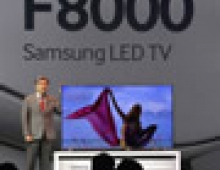
US TV Market Set For Decline in 2013
U.S. TV shipments are forecast to decline for a second year in a
row in 2013, but growth will resume next year as the liquid crystal
display television (LCD TV) segment regains some of the strength it had lost in the past year.
Shipments in 2013 of televisions into the U.S. market will amount to a
projected 36.6 million units, compared to 37.6 million last year,
according to an IHS iSuppli report. The anticipated 2.7
percent contraction will be smaller than the 5.8 percent slide suffered
by the industry in 2012 when domestic TV shipments retreated from 39.9
million units in 2011. However, it will mean that shipments will have
declined for two straight years by the time 2013 is over.
Despite the current negative picture, the industry is poised to see expansion return next year as shipments tick up to 37.8 million units, marking the beginning of at least a four-year run of steady growth.
"U.S. television demand is being hit by the double whammy of the plunge in both the plasma and LCD TV segments," said Veronica Thayer, analyst for consumer electronics & technology at IHS. "After peaking in 2010, plasma sales now are on a terminal decline. Meanwhile, the mature U.S. LCD TV market contracted in 2012 as most consumers already own one or more sets."
Plasma TV shipments last year shrank a steep 24 percent to 3.6 million units compared to their 2011 level, and LCD TV shipments descended 3 percent to 33.8 million units.
But while plasma shipments will continue to be down this year as part of an irreversible trend toward extinction, LCD TV shipments will be up 3 percent, reversing the losses of last year and coming close to the segment?s 2011 shipment level. LCD TV shipments will grow another 6 percent next year, pulling the overall U.S. TV space out of its slump.
Meanwhile, the introduction of organic light-emitting diode (OLED) televisions will start to work its magic on the industry, especially because the advanced sets will sport perfect black colors and much thinner profiles than already slim-based LED-backlit sets. South Korea?s LG Electronics and Samsung Electronics will lob the first volleys in the first half of 2013 by each launching 55-inch models -- first previewed in January at the Consumer Electronics Show in Las Vegas, and vastly different from the tiny 11- and 15-inch OLED TVs shown several years ago.
A total of just 56,000 OLED TVs will ship cumulatively in 2013 and 2014, with sets commanding extremely high retail pricing because of a lack of large-scale manufacturing. But shipment numbers will grow quickly from 2014 onward, jumping to 370,000 by 2015, and then surging to 1.9 million units by 2017. Revenue from OLED TVs could reach as much as 21 percent of the total TV market revenue for that year.
Owing to the high retail price of OLED TVs, this display type will account for a larger percentage of revenue compared to shipments in the total U.S. TV market.
Despite the current negative picture, the industry is poised to see expansion return next year as shipments tick up to 37.8 million units, marking the beginning of at least a four-year run of steady growth.
"U.S. television demand is being hit by the double whammy of the plunge in both the plasma and LCD TV segments," said Veronica Thayer, analyst for consumer electronics & technology at IHS. "After peaking in 2010, plasma sales now are on a terminal decline. Meanwhile, the mature U.S. LCD TV market contracted in 2012 as most consumers already own one or more sets."
Plasma TV shipments last year shrank a steep 24 percent to 3.6 million units compared to their 2011 level, and LCD TV shipments descended 3 percent to 33.8 million units.
But while plasma shipments will continue to be down this year as part of an irreversible trend toward extinction, LCD TV shipments will be up 3 percent, reversing the losses of last year and coming close to the segment?s 2011 shipment level. LCD TV shipments will grow another 6 percent next year, pulling the overall U.S. TV space out of its slump.
Meanwhile, the introduction of organic light-emitting diode (OLED) televisions will start to work its magic on the industry, especially because the advanced sets will sport perfect black colors and much thinner profiles than already slim-based LED-backlit sets. South Korea?s LG Electronics and Samsung Electronics will lob the first volleys in the first half of 2013 by each launching 55-inch models -- first previewed in January at the Consumer Electronics Show in Las Vegas, and vastly different from the tiny 11- and 15-inch OLED TVs shown several years ago.
A total of just 56,000 OLED TVs will ship cumulatively in 2013 and 2014, with sets commanding extremely high retail pricing because of a lack of large-scale manufacturing. But shipment numbers will grow quickly from 2014 onward, jumping to 370,000 by 2015, and then surging to 1.9 million units by 2017. Revenue from OLED TVs could reach as much as 21 percent of the total TV market revenue for that year.
Owing to the high retail price of OLED TVs, this display type will account for a larger percentage of revenue compared to shipments in the total U.S. TV market.



















